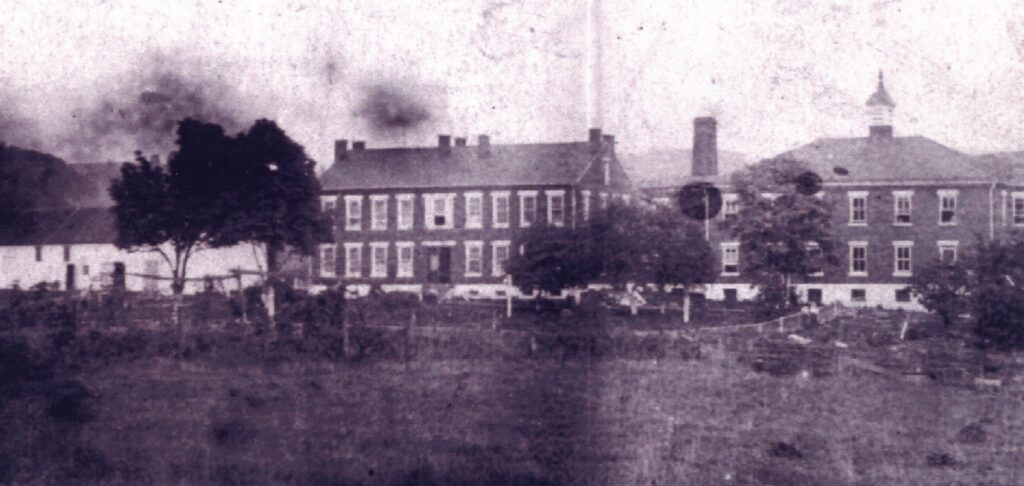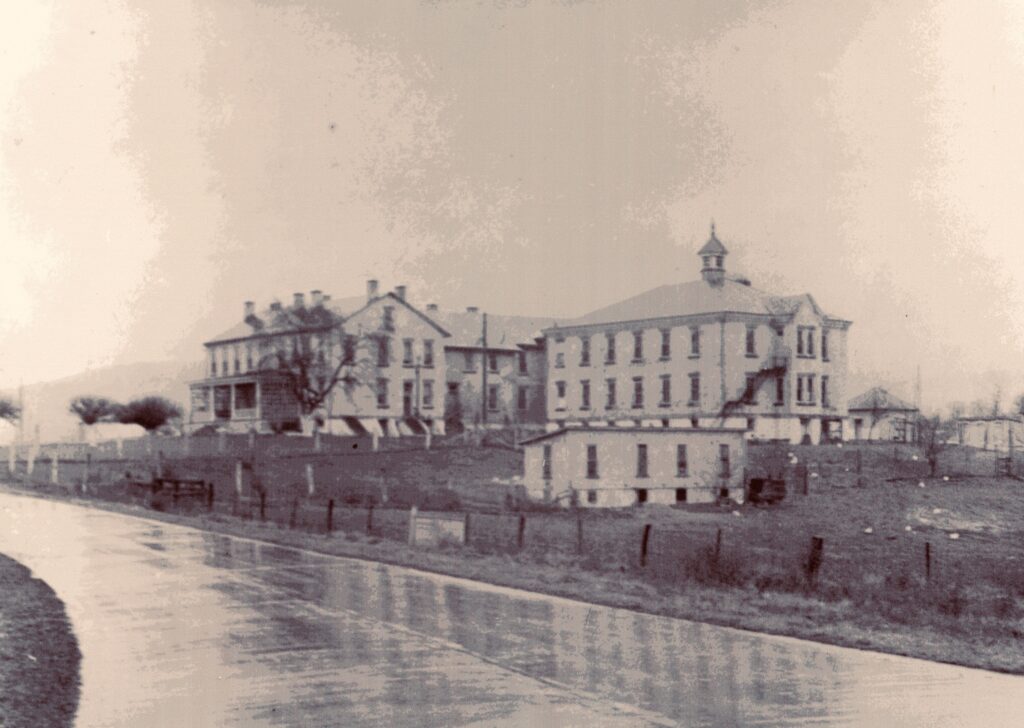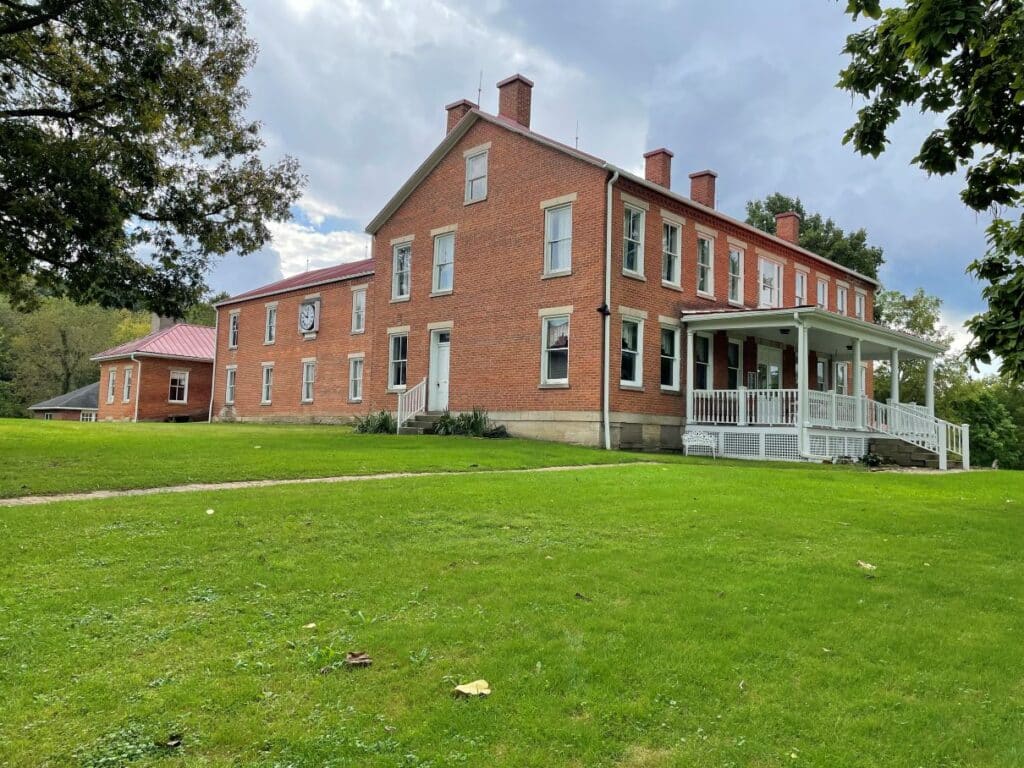The Story of an Aged Institution
Just before the start of the Civil War legislation was passed in Pennsylvania, and many other states throughout the country, for each county to establish houses to care and support the poor. These houses often started out as converted family homes, usually beginning small in scale and expanding greatly over time.
In 1861, the County of Greene acquired a large farm in western Franklin Township upon which stood a twelve room farmhouse built in 1857 by the Rinehart family. The structure was a large Georgian Revival with a center hall and finely decorated rooms, an extravagant home for the time. This home and farm was to be the site of the Greene County Poorhouse.
The original house was to be used as a residence for the steward of the poorhouse, and the new two story wing, expanding straight out of the rear elevation of the house contained a long hallway with ten rooms running along the hall on the first floor, and an identical configuration of the second. Early in 1862, the county approved measures to install a new public roadway that would run in front of the facility. This roadway became PA Route 21, later known as Old 21, and is now Rolling Meadows Road.
It didn’t take long for the residents to arrive. Issac Pipes was the first inmate to live in the facility, having been admitted on the 2nd of June 1862. Pipes was 40 years old, and formerly resided in Franklin Township. The records indicate that he had never held a job or an occupation of any sort, and his reason for admission was noted as “crippled”.
Throughout the duration of the year, 83 other souls would call the Greene County Poorhouse “home”. Among the various reasons for admission to the poorhouse is a sundry list including feeble minded, insane, convulsions, blind, inbred, old and demented. Poor, or impoverished, are among the least common reasons for people to be brought to the poorhouse in the 19th century. It seems like so many other similar institutions, the Greene County Poorhouse served a purpose more akin to what we would now call an asylum than a home for those who could not make due on their own.
Records and newspaper accounts indicate that things were rough in the early days. Overcrowding was an early issue, and the attic was converted into dormitory space to accommodate the overflow from the twenty dorm rooms. The steward oversaw operations of the farm, keeping the facility self sufficient, raising livestock, growing crops and tending to the maintenance of what was already a 32 room building.

In 1881, a lengthy article written by a Mr. Ourt about poorhouses and Almshouses from across the country was featured in Atlantic Monthly, a popular magazine of the time, criticized the living conditions of the Greene County Poorhouse, and that prompted construction of a new wing in 1886.
The new wing, contained twelve new dorm rooms and a bathroom facility on two floors with a basement of a similar layout. When the new wing was constructed, the 1861 wing was reconfigured, and five of the rooms on the first floor were converted to a large dining facility. This brought the total number of dorm rooms in the building to 38, for a total of 50 rooms in the facility including the rooms in the steward’s home.
During this time period a new steward came to the facility. William B. Cage, by many accounts a cruel and sadistic man. The Waynesburg Republican published several articles about him in the late 1880’s and early 1890’s. A very concise report appeared in 1890 that detailed many of his inhumane treatments.
Cage was known to use the food set aside for the residents to throw lavish parties in the “front of the house” – or the stewards residence – while leaving only scraps and leftovers for the inmates. He was accused of chaining individuals up in the basement rooms of the newest wing and allowing them to starve as punishment for minor infractions, and forcing residents to bath in the creek behind the poorhouse in the icy cold winter months. He was also known to have a cane with which he commonly beat the residents. It was even reported that Cage staffed the kitchen with a head cook who was blind, and that as a result the food consumed by the inmates was generally undercooked and filled with flies.
The 1890 article contained several firsthand accounts by the inmates of the poorhouse detailing multiple instances. Interestingly enough, all of the inmates who made these reports disappeared from the records. Whether they were sent away or moved on elsewhere is uncertain. Or did Mr. Cage permanently silence those poor souls who were brave enough to speak out about the atrocities he was committing?
When the knowledge became public, Mr. Cage was removed from the facility and returned to private life, dying in 1914 at the age of 78.

By the early 1900’s a new kitchen facility was constructed with an attached bake house, bringing the size of the facility to 52 rooms total. The new kitchen was dedicated for the use of the inmates, and the old kitchen in the “front of the house” was used only by the steward and his family.
The 1900’s brought a renewed sense of peace and happiness to the poorhouse and with the removal of Cage, new stewards were hired and living conditions improved greatly. So much so, that there are even letters archived from inmates who were transferred to other institutions throughout the state, begging to return to the kind treatment they had grown accustomed to in the Greene County Poorhouse, or as it was then called “The Green Hills Farm.”
In the early 1960’s, the old poor farm had morphed into a retirement home for the aged of the community and was soon replaced by the Curry Home that was built across the road. The old house and grounds of the farm would remain vacant for a few years before being acquired by the Greene County Historical Society in 1971 to operate a local history museum that is still in existence today.

This article originally appeared in the September 2019 issue of the GreeneScene Community Magazine published by Direct Results. Discover more at www.greenescenemagazine.com.
Visit the Greene County Historical Society Museum during their seasonal operating hours and explore various admission rates for kids, adults and seniors. Enhance your trip today with upcoming presentations and events!







